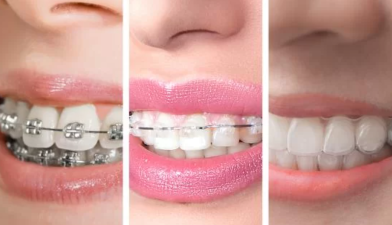With the progress of modern dental medicine, people can achieve their pursuit of beauty even if they are not born with beautiful teeth. Traditional orthodontic appliances include metal braces, lingual braces and ceramic braces. The common characteristics of these braces are:

With the progress of modern dental medicine, people can achieve their pursuit of beauty even if they are not born with beautiful teeth. Traditional orthodontic appliances include metal braces, lingual braces and ceramic braces. The common characteristics of these braces are:
①More obvious and not very beautiful;
②Usually the treatment process lasts for 1-2 years and cannot be removed. Invisible braces subvert the force-adding principle of traditional braces and solve the drawbacks of traditional braces. Wearing invisible braces made of transparent materials and removable at any time eliminates the embarrassment of "iron teeth and steel teeth". But how should we choose?

Traditional correction:
Traditional fixed correction is to bond a small piece called a bracket on the teeth through a traditional jaw deformity corrector, tie the correction archwire to it, and move the teeth to achieve the correction purpose. However, because there are many correction devices on the tooth surface, it gives people the feeling of "iron mouth and steel teeth".
● Correction principle: Orthodontics is a physical reconstruction process. By applying external force to the teeth or jaws, the teeth move in the predetermined direction. The alveolar bone on the side of the teeth under pressure is absorbed, while the alveolar bone is reconstructed on the other side (tension side), that is, the new bone is deposited. In this way, the teeth move from one position to a new position due to the external force until the force is stopped. At the same time, during the correction process, the soft tissues such as the muscles around the mouth and the upper and lower jaws will also undergo corresponding changes due to the existence of traction, so that the entire oral environment reaches a new balance. In this process, it is key to select a doctor with rich experience in orthodontics and tailor a correction plan for the patient!
● Correction cycle: According to the patient's own teeth and cooperation, it usually takes 1 to 2 years for ordinary wires to correct teeth.
● Note: Traditional brackets are a bit troublesome for daily cleaning. Therefore, during the correction period, patients should choose toothbrushes with appropriate toughness and elasticity to achieve the effect of cleaning the mouth, such as interdental brushes, single-beam toothbrushes, etc. In addition, dental floss and water flossers can also be used to further clean the mouth. During orthodontic treatment, in addition to following the doctor's instructions, you must also take care of the braces on your teeth to prevent the accessories of the braces from falling off. Therefore, during the correction period, you should avoid eating large pieces of hard food, such as cutting apples into small pieces before eating. Foods such as bone foods, crabs, and nuts should be temporarily stopped. There will be many unexpected factors during the period of wearing braces, such as improper cleaning causing periodontitis, or the correction direction not going as expected. Therefore, you must listen to the doctor and return to the doctor in time.
Invisible correction:
Invisible correction technology is based on the specific situation of each patient. After establishing a correction plan, it simulates the correction process through dedicated and advanced computer software, and uses elastic and transparent medical polymer materials to make a brace for each process. The entire correction process is to achieve the correction purpose by replacing this series of braces.
● Correction principle: Every time you wear it, the teeth will feel the force and move to the position designed by the brace. Replace the next set of braces every two weeks, and the teeth will gradually move from the initial deformed state to the normal arrangement state, thus achieving the correction effect.
● Correction cycle: The specific correction cycle needs to be analyzed according to the patient's specific situation, generally about 1 to 3 years.
● Note: Although invisible braces have good effects and outstanding advantages, they are not suitable for everyone. It is recommended to be decided by the clinician after a face-to-face consultation. It requires a higher degree of cooperation between doctors and patients.
The difference between invisible braces and traditional braces
1. The difference in appearance
First of all, the most intuitive is their appearance. Traditional metal braces, which are composed of metal wires and brackets, look more obvious. Invisible braces use transparent braces that are almost unnoticeable, which is why it is called "invisible". For those who care about beauty or don't want others to know that they are correcting their teeth for work or social reasons, invisible braces are undoubtedly a better choice.
2. Difference in comfort
Traditional correction: Traditional dental correction uses metal brackets, which may irritate the buccal mucosa and surrounding soft tissues. The inner wall of the mouth may be rubbed by the brackets to cause oral ulcers, and there is also a certain degree of irritation to the periodontal tissue.
Invisible correction: Since there are no traditional brackets, wires and other correction devices, the correction process is no longer painful. It can be disassembled freely, will not irritate the inner wall of the mouth, has a high degree of comfort, and has the lowest irritation and discomfort to the periodontal tissue.
3. Convenience of cleaning and maintenance
Invisible correction also has its advantages in cleaning and maintenance. The braces of invisible correction can be removed at any time, which means you can take them off when eating and brushing your teeth, which is convenient for maintaining oral hygiene. The metal braces of traditional correction are not easy to clean, and it takes more time and effort to ensure the cleanliness of teeth and braces.
4. Difference in treatment time Traditional correction: It takes an average of about 1 to 2 years and is not removable. Generally, follow-up visits are made every 4-6 weeks. If there are problems such as brackets falling off, you should come to the outpatient clinic in time for treatment. Therefore, it is suitable for people who have sufficient time to follow up on time.
5. Differences in dietary restrictions Traditional correction: Diet will be restricted, you can't eat hard things, basically say goodbye to foods like ribs and pig's trotters, and even hard fruits have to be cut into pieces. Invisible correction: You can eat and drink as much as you want.
6. Differences in the population that can adapt to Finally, let's talk about the differences in the population that can adapt to. Invisible correction is mainly suitable for mild and moderate tooth misalignment. For severe cases, traditional correction or other methods may still be required. Traditional correction is suitable for various degrees of tooth misalignment, including some complex cases.
Of course, each correction method has its advantages and disadvantages, and which one to choose depends on the actual situation and needs of the individual. If you are considering orthodontic treatment, it is recommended that you consult a professional dentist first and let them provide you with personalized advice based on your specific situation. In short, remember that no matter which correction method you choose, it is important to find an experienced doctor and follow their guidance to ensure that the correction process goes smoothly and you will eventually have neat and healthy teeth.


_20241106154012A037.jpg)